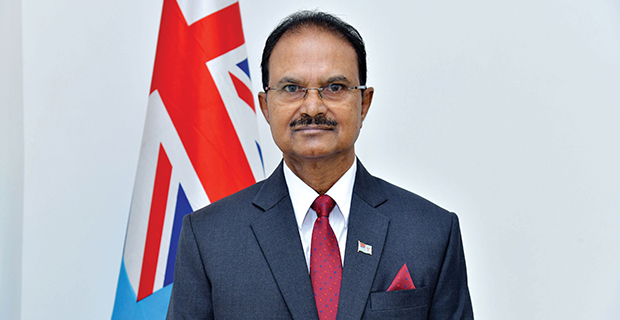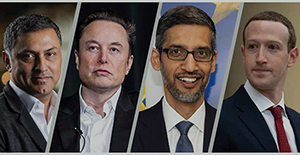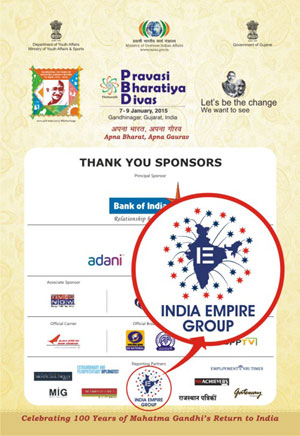“PM Modi’s visit was transformative”
In an interview with Bula Devi, Consulting Editor (International Affairs), India Empire, H.E. Mr Jagnnath Sami, High Commissioner of the Republic of Fiji to India, highlights the evolution of India–Fiji relations since PM Modi’s 2014 visit, discussing cultural heritage, digital initiatives, healthcare, trade, climate action, and future collaboration.
How do you assess the long-term impact of PM Modi’s 2014 visit and FIPIC on India–Fiji relations?
PM Modi’s 2014 visit to Fiji was transformative, launching the Forum for India–Pacific Islands Cooperation (FIPIC)—a platform that has met multiple times to expand cooperation from capacity-building to connectivity and climate resilience. FIPIC ensures that Fiji and Pacific priorities—Blue Economy, health, digital infrastructure, and disaster resilience—remain central on India’s agenda, while providing Fiji with structured access to Indian expertise and financing.
How is Fiji preserving and promoting the Girmitiya heritage with India and the Indo-Fijian community?
Fiji and India have strengthened cultural partnerships through Hindi language programs, scholarships, and major cultural events, keeping Girmitiya history visible to younger generations. Fiji’s hosting of the World Hindi Conference highlighted the country’s unique Hindi heritage and deepened global awareness of Indo-Fijian contributions.
What digital infrastructure projects have been implemented with India’s assistance, and how have they helped local communities?
Collaboration includes knowledge-sharing on Digital Public Infrastructure (DPI), covering identity systems, payments, and interoperability. Fiji’s leadership has engaged with India’s UIDAI to explore digital ID and service delivery lessons. These initiatives improve last-mile service delivery, reduce leakages, and make public services more inclusive, especially in remote island communities.
What progress has been made in healthcare collaboration, including medical training and public health initiatives?
India and Fiji cooperate in public health, clinical training, and tertiary care referrals. India has agreed to build a 100-bed super speciality hospital in Fiji. Additionally, a pharmacopeia agreement provides access to generic medicines, improving local capacity and healthcare access. Partnerships also include medical education, exchanges, and hospital collaborations.
How have India–Fiji defence and maritime security agreements translated into action?
Defence cooperation is operationalised through Indian Navy ship visits, maritime domain awareness exercises, and HADR collaboration. A Joint Working Group on Defence ensures practical implementation of maritime security agreements, enhancing Fiji’s EEZ monitoring, disaster response, and interoperability with Indian forces.
What joint projects exist to address climate change, renewable energy, and disaster resilience?
Through FIPIC and bilateral channels, India supports Pacific climate priorities via resilient infrastructure, solar electrification, capacity-building, and concessional financing for climate-smart projects. These initiatives align with Fiji’s Nationally Determined Contributions (NDCs) and address community-level adaptation needs.
How have Hindi language programs, cultural festivals, and educational exchanges strengthened people-to-people ties?
Hindi programs, cultural festivals, ICCR scholarships, and artist/scholar exchanges have significantly expanded Indo-Fijian connections. Hosting of the World Hindi Conference in Fiji spotlighted Indo-Fijian contributions and strengthened global academic networks around Fiji Hindi and Girmitiya studies.
What steps have been taken to boost trade and economic cooperation, and how are Indo-Fijian entrepreneurs participating?
Bilateral trade and investment frameworks now cover sectors including agro-processing, ICT, business services, film/creative industries, pharmaceuticals/med-tech, and tourism supply chains. Indo-Fijian entrepreneurs play a pivotal role, serving as conduits for innovation and business engagement between the two nations.
Tourism is the backbone of Fiji’s economy. How is India contributing to tourism growth, and what opportunities exist for Indian visitors and investors?
India represents a high-potential tourism market for Fiji. Opportunities include wedding and MICE tourism, wellness retreats, diving packages, and film destinations. Collaborations are supported by digital marketing, curated travel packages, and partnerships between Indian and Fijian travel trade sectors.
Looking ahead, what are the key areas for collaboration, particularly in promoting heritage, youth engagement, and sustainable development?
Key areas of future cooperation include:
Heritage & culture: Joint archives, oral-history projects on Girmitiya heritage, and regular cultural seasons in Suva/Nadi and Indian metros.
Youth & skills: Technical and vocational training (TVET), nursing, IT, and hospitality pipelines with Indian partners; internships and faculty exchanges.
Sustainable development: Solar mini-grids, resilient health facilities, telemedicine nodes, coastal protection, and climate-smart agriculture.
Digital public services: Phased adoption of DPI building blocks—ID, payments, paperless workflows—adapted to island geographies with Indian technical assistance.











Comments.